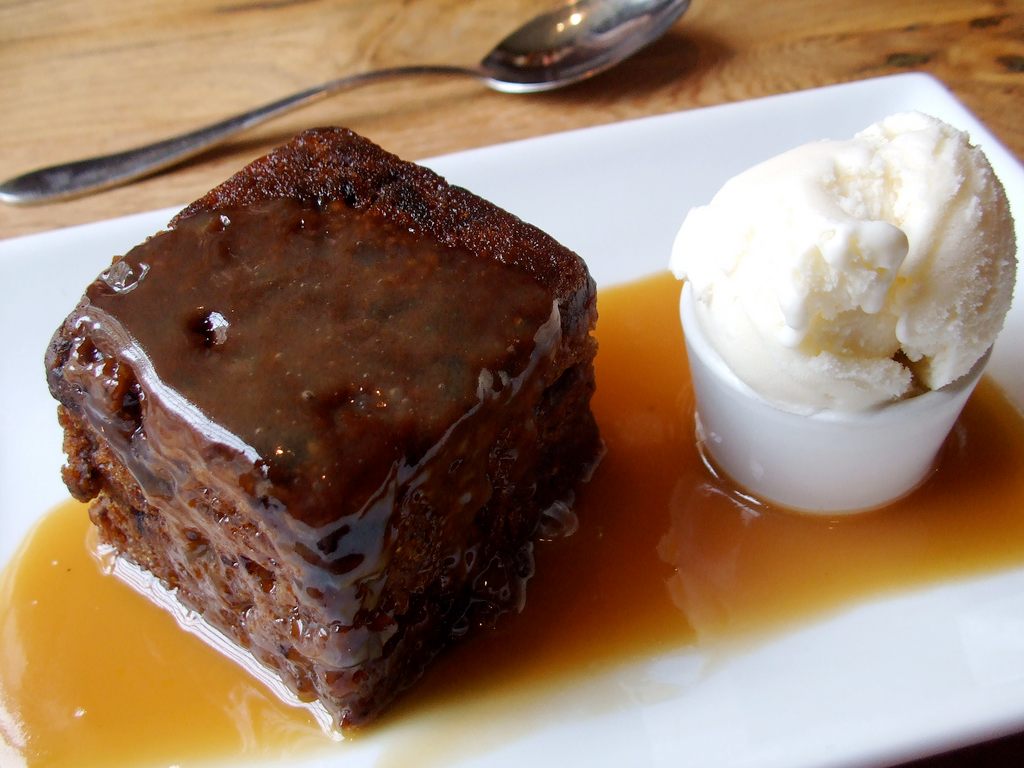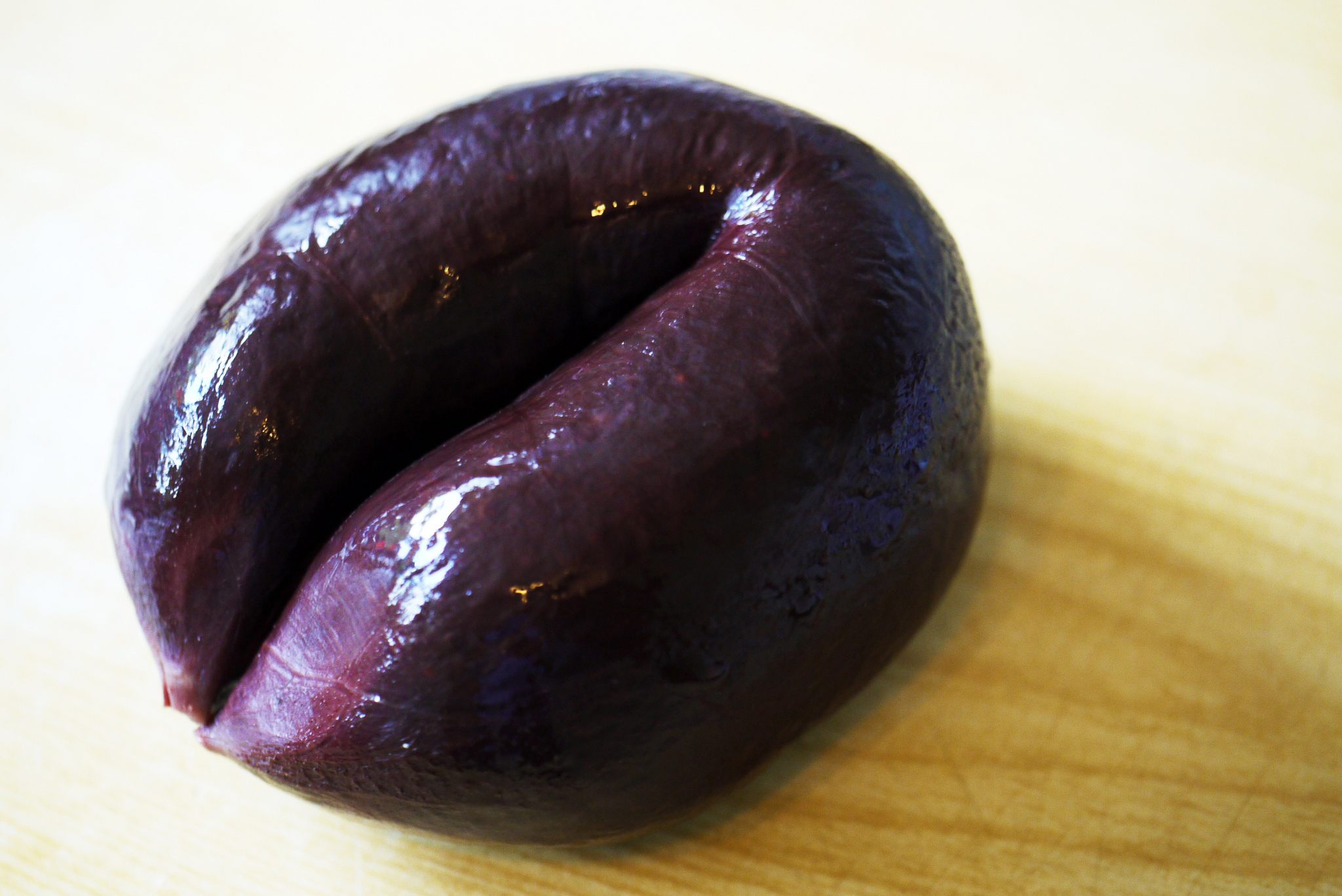What Brits Talk About When they Talk About Pudding

A traditional Christmas Pudding, decorated with holly and set alight before eating. (Photo: James Petts/flickr)
On the competition TV show The Great British Bake Off (which has recently exploded in popularity in the U.S. thanks to airing on PBS and Netflix under the name The Great British Baking Show), most seasons feature at least one challenge dedicated to “puddings.”
For Americans watching the show, this word, like “biscuit,” provides a fun linguistic nibble: a word we’re familiar with that suddenly appears to mean something totally different.
But pudding’s meaning is incredibly far-ranging, much more so than any American might imagine. Here is a partial list of classic British dishes that are at least sometimes referred to as a pudding:
- Plum pudding or Christmas pudding, a boiled or steamed fruitcake (which does not traditionally include plums)
- Black pudding, a sausage made of blood thickened with oatmeal
- Yorkshire pudding, a quickbread made of a batter similar to pancake batter that’s heated quickly to create a popover-like dinner roll
- Sticky toffee pudding, a cake filled with chopped dates that’s covered in caramel and sometimes cream or ice cream
- Steak and kidney pudding, a meat pie consisting of the two meats in its name
- Pease pudding, basically a split-pea soup with a thicker texture, closer to hummus
How in the world can all of these items be puddings? They seem to have no common ground: they can be savory or sweet, can be cooked in any of several ways (baked, steamed, boiled, fried), can be stuffed or not, can incorporate a wide variety of ingredients. What is the point of a word that seems so inexact?
Adam Taylor, a London-born journalist who now writes for the Washington Post, says that even in the UK it’s confusing. “If someone said to me, ‘Do you want pudding?’ I would assume they meant dessert,” he says. “But there are Yorkshire puddings which are obviously savory and not dessert.”

Yorkshire pudding, a savory dish made with eggs, flour and milk or water, and usually eaten as part of a traditional roast dinner. (Photo: Sam Greenhalgh/fiickr)
One of the fundamental obstacles to understanding exactly what a Brit means when he or she says “pudding” is that the word has two basic uses: one refers to a course of a meal, and one refers to specific dishes. Those specific dishes can be, but don’t necessarily have to be—and, in fact, some would never be—served during the “pudding course” of a meal.
“In certain dialects (including in the influential southeast), it is a synonym for (more American) ‘dessert,’” writes Lynne Murphy, an American linguist at the University of Sussex who maintains a blog on linguistic differences between the U.S. and the U.K., in an email. “The pudding course is similar to dessert and served at the end of the meal—puddings are substantial, we don’t refer to ice cream as pudding for example,” writes Jill Coombe, owner of the Three Ways House Hotel in Gloucestershire and founder of the Pudding Club, which bills itself as being “devoted to preserving the tradition of the great British pudding.”
That adds up; for Taylor, who’s from London, which is in the southeastern part of the country (though not included in the official region of South East England for reasons that couldn’t be less important to our discussion of puddings), “pudding” means a course, and also anything you might eat during that course. You can think of it like “dessert”: for Americans, “dessert” refers to both the final, sweet course of the meal and also any dish, be it pie or cake or ice cream, that might be served within the course.

Sticky Toffee Pudding, a steamed dessert of sponge cake, dates and toffee sauce. (Photo: katherine/flickr)
But that still leaves us with a heap of savory dishes that would never conceivably be served in a dessert course. So where did those puddings come from?
There are a few theories about the origin of “pudding”. The most common is that the word derives from boudin, a French word generally referring in modern times to sausage. Boudin in turn derives from the Latin botellus, which refers to the intestine. (Intestines were and sometimes still are used as sausage casings.) Many classic British puddings are weirdly sausage-like; take the Christmas or plum pudding, which is a mixture of dried fruits, nuts, butter or suet, eggs, flour or breadcrumbs, alcohol, and spices. These days your typical Christmas pudding is steamed, but up until the 20th century it was more typical to wrap it in cloth and let it dry for weeks, or sometimes months—just like a sausage.
Other theories hold that “pudding” comes from more Germanic sources. The Oxford English Dictionary has a long list of possibly related terms, including the Old English puduc, the Pomeranian puddik, and the Westphalian puddek. These words have a different meaning; usually they involve some combination of “fat” or “soft,” as an adjective, which is where the modern English word “pudgy” comes from. Other times they refer to swellings or boils or lumps.
Both explanations make sense—Murphy said about the boudin explanation: “I have no reason to be suspicious of that etymology,” and certainly the idea of both softness and swelling can be applied to most modern British puddings.
But that isn’t enough. How can sausage, fried bread, meat pie, and cake all come to be grouped under the same term?
“It’s what the linguist George Lakoff might call a ‘radial category,’” writes Murphy. “The pudding types all have some things in common with some other pudding types, but not everything, and it’s mostly a matter of convention that they continue to be called ‘pudding.’” Lakoff is a cognitive linguist who’s best known for his thesis that the specific metaphors used in language can shape cognition and perception of the world. A radial category is a category that allows a variety of different items to be grouped under a single umbrella for a variety of reasons. You can think of it sort of like a jellyfish. The body of the jellyfish is the word, and all its tentacles are the threads that make up the concept.

Summer Pudding, a dessert made with bread, fruit and fruit juice. (Photo: Sarah/WikiCommons CC BY 2.0)
There are lots of examples of radial categories. Take “bread.” Some of the tentacles here might be “a baked dough,” “contains yeast,” “consists of flour of some sort,” and “serves as the starch component of a meal.” Now think about all the weird items we refer to as breads. Banana bread contains no yeast and doesn’t rise. Cornbread also has no yeast, and is made from a batter rather than a dough. Flatbread has no yeast and is often cooked in a pan rather than baked. Some breads are made from potato or rice paste or various other ingredients. Some are sweet, some are savory. Some are fluffy, some are crisp. For an item to be considered a bread, it has to grab onto one of the many tentacles that make up the vague and loosely-defined category of “bread,” but not all of them.
Looking at the “British pudding” jellyfish, one of the most popular tentacles is the cooking method, which involves hot water somehow. Many puddings are either steamed or boiled, including sticky toffee pudding and Christmas pudding. Another tentacle would be the use of suet, which is hard animal fat taken mostly from around an animal’s kidneys. A further tentacle would be “a thickened or congealed mixture of stuff that attains a goopy consistency.” That’s how we get black pudding, which is a congealed blood sausage, but it’s also how we end up with rice pudding, which uses the starch given off by rice to thicken the surrounding milk.

Black pudding, a type of blood sausage. (Photo: Smabs Sputzer/flickr)
If an item gets stuck to one or more of these tentacles, it’s considered to be within the category of “pudding.” But some items that are considered puddings might have gotten stuck to totally different tentacles; one pudding might have gotten stuck to the “dessert” tentacle, so it’s considered a pudding because it’s a dessert. But another might get stuck to the “suet” tentacle, so it’s a pudding because of that. Steak and kidney pudding, which Americans would identify as a meat pie, would grab onto that suet tentacle, because its crust is made from suet.
This leaves a burning question: what do Brits call American-style pudding, which, for the record, is a smooth dessert made from thickened dairy? “The Jell-O pudding kind of pudding doesn’t exactly exist here,” says Murphy, “but if it did, it would be called ‘custard.’”
Gastro Obscura covers the world’s most wondrous food and drink.
Sign up for our regular newsletter.
























Follow us on Twitter to get the latest on the world's hidden wonders.
Like us on Facebook to get the latest on the world's hidden wonders.
Follow us on Twitter Like us on Facebook